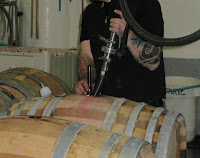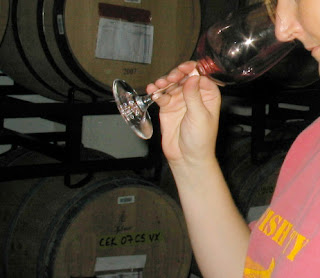
We had an opportunity to tour a winery facility in San Francisco at the end of harvest. We learned first hand what it takes to make truly first class luxury red wines.
This winery produces wines in small lots, 25 to 1200 cases and often fetch scores in the 90s from the Spectators and the Parkers. The wines are hand crafted. Each berry is inspected and sorted after going through the de-stemmer and before going to the crusher.

Fruit arrives at the winery from top quality vineyards from Santa Barbara up to Washington. The fruit is then put through a destemmer and sent down along a belt where the berries are sorted. Removing unripe, green berries, stems, leaves and other green bits prevents green vegetable and garlic like notes from creeping into the wine. The crushing process is done with a machine that can be set to break from 0% to 100% of the berries. This decision is made by the wine maker to determine the amount of tannins that will be immediately available during fermentation.
 The “must” is loaded into sterile T bins. The T bins hold one ton (T for ton) of fruit which will yield approximately two barrels of wine or 45 to 50 cases. The alcoholic fermentation takes place in these T bin. In small lot production, the must will begin to separate and the juice will flow to the bottom and the berries float to the top. This forms a dense cap on the top that must be “punched down” every four hours, around the clock. This breaks up the cap, oxygenates the must and keeps the fermentation going. It also helps the wine maker control the extraction of color and tannins from the seeds and skins.
The “must” is loaded into sterile T bins. The T bins hold one ton (T for ton) of fruit which will yield approximately two barrels of wine or 45 to 50 cases. The alcoholic fermentation takes place in these T bin. In small lot production, the must will begin to separate and the juice will flow to the bottom and the berries float to the top. This forms a dense cap on the top that must be “punched down” every four hours, around the clock. This breaks up the cap, oxygenates the must and keeps the fermentation going. It also helps the wine maker control the extraction of color and tannins from the seeds and skins.
 After the fermentation is complete, the wine is ready to be barreled. The free run is siphoned off from the bottom of the T bin. This is generally the higher quality wine. In large wineries, this is sent off to be finished as higher quality wines. In this operation, because the quality of the fruit is higher and the methods used, the wine will be carefully pressed. The winemaker must be careful not to press so hard that excess tannins are pulled from the skins and seeds. If the client has several barrels, the free run may be fermented separately and blended at the end with the pressed wine.
After the fermentation is complete, the wine is ready to be barreled. The free run is siphoned off from the bottom of the T bin. This is generally the higher quality wine. In large wineries, this is sent off to be finished as higher quality wines. In this operation, because the quality of the fruit is higher and the methods used, the wine will be carefully pressed. The winemaker must be careful not to press so hard that excess tannins are pulled from the skins and seeds. If the client has several barrels, the free run may be fermented separately and blended at the end with the pressed wine.
 Taking a sample of this future Bordeaux style wine from the press, we see the impression the thick Cabernet Sauvignon grape skins imparted on this ferment. Coming out of the press, the wine is cloudy, very acid, tart and quite fruit forward to say the least. But you can start to discern the characteristics of the wine. This wine already has the tannin structure, color, and flavor components of a really great wine.
Taking a sample of this future Bordeaux style wine from the press, we see the impression the thick Cabernet Sauvignon grape skins imparted on this ferment. Coming out of the press, the wine is cloudy, very acid, tart and quite fruit forward to say the least. But you can start to discern the characteristics of the wine. This wine already has the tannin structure, color, and flavor components of a really great wine.
Oak tannins are important to the structure and mouth feel of the wines. Wines without a good tannin structure will not be suitable for aging. This can be by design. A winery maker can impart a tannin structure with maturity at bottling time so the wine is drinkable in the near future, or give it a structure for aging. Much of this is dependent on the type of barrel. New barrels will impart heavy oak, used barrels will impart little oak but allow the wine to mellow in structure. Wineries such as Heitz, will start with an American barrel and switch to French oak to finish the barrel aging. Barrel sample are taking for time to time to determine if the wine is on the right path or needs an intervention to ensure that time and wine converge into the desired style.
American oak will give the wine a very strong oak, wild component. American oak barrels costs about $300 to $400 a piece whereas French oak barrels range from $850 to $1000. As mentioned for luxury wines, American oak is used intentionally for flavoring.

Once filled, the barrels are stacked in a temperature controlled rooms to control the secondary fermentation and aging. Oak aging allows a small amount of oxygen to enter the wine and transform the tannins into their final, drinkable form. At this stage, the tannins are still harsh, the wine is very fruit forward, sweet and a bit unbalanced. The oak will allow some the moisture to evaporate out of the wine. The barrels are topped off, (about a cup or so) every two to three weeks.
 At the end of fermentation, the winemaker has more decisions to make. Which type of barrel to use for final aging, how long to barrel age and what adjustments are needed for the final state of the wine. Now the wine tastes young, slightly unbalanced and still tannic. Our winemaker inserted a thief (glass tube device used to sample barrels) into a barrel and drew off a sample of Zinfandel that was at this stage. Taster B and I knew that we tasted a very special wine that will be a delight when it is ready to bottle. It has all of the components in place, the aromas, fruit forward, smoother tannins and good mouth feel that one would expect from a big Zinfandel.
At the end of fermentation, the winemaker has more decisions to make. Which type of barrel to use for final aging, how long to barrel age and what adjustments are needed for the final state of the wine. Now the wine tastes young, slightly unbalanced and still tannic. Our winemaker inserted a thief (glass tube device used to sample barrels) into a barrel and drew off a sample of Zinfandel that was at this stage. Taster B and I knew that we tasted a very special wine that will be a delight when it is ready to bottle. It has all of the components in place, the aromas, fruit forward, smoother tannins and good mouth feel that one would expect from a big Zinfandel.

When the wine is ready, final blending will take place. There are thirty to forty decisions that go into luxury wine production. From what varietals to what yeast, to what barrel to what label. The care and craftsmanship that goes into a luxury wine is extensive and labor intensive. For us, we gained a true appreciation for what it takes to make a great wine.






1 comments:
That's incredible all the process that people have to make to drink a great wine that's why I love it. Generic Viagra Buy Viagra
Post a Comment